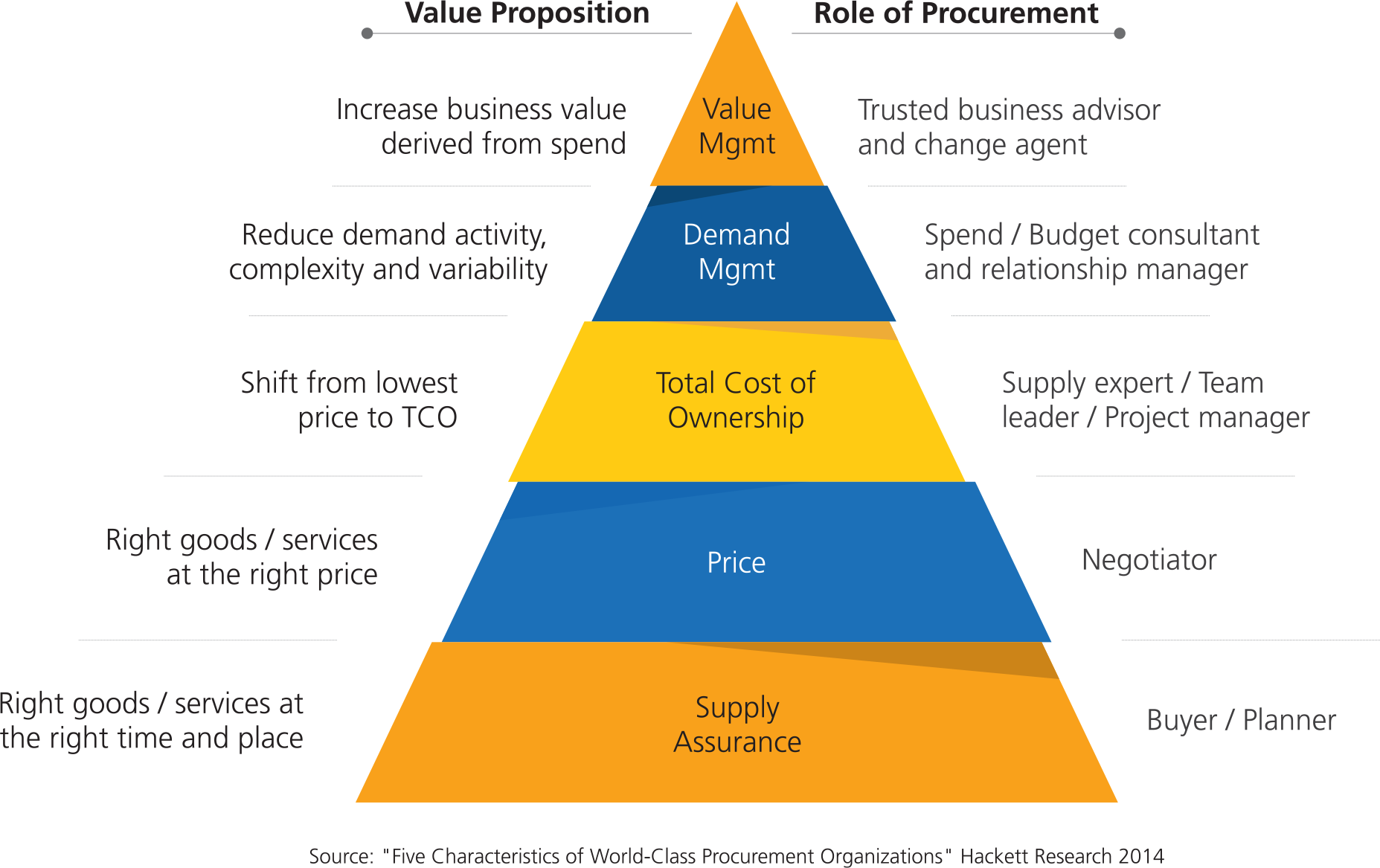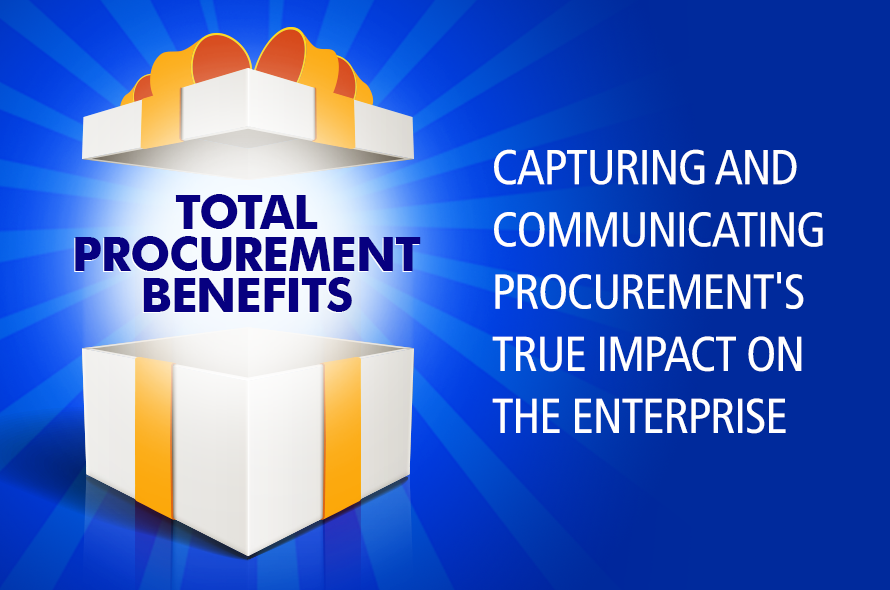Introduction
The role of procurement is fast evolving, creating new requirements for talent and skill, with core competencies going beyond just category expertise, compliance management and change leadership. Procurement professionals are now expected to bring business acumen, structured problem solving, influencing skills and systems thinking to the table.
Procurement is being valued more than ever as it plays the role of a strategic advisor, a trusted business partner, a financial steward supporting the CFO’s organization and a supply network optimizer bringing deep value beyond savings. This additional value beyond savings can be expressed, along with actual savings, as Total Procurement Benefits (TPB).
This paper discusses the importance of effectively capturing and communicating TPB in elevating the status and influence of procurement within the enterprise and how to go about it.
Enterprises have various methods for measuring procurement savings, often mutually established between the procurement and finance departments, and reflective of the company’s goals. Companies with cash flow challenges may give procurement “credit” for cost-avoidance cash levers, such as longer payment terms. Some enterprises will recognize cost avoidance on capital expenditures, such as building construction, based on discounts negotiated from an original quote that serves as a baseline. Many organizations today recognize and emphasize hard-dollar savings, often tied with a zero-based budgeting approach that requires costs to be justified and accounted for year-over-year on a bottom-up basis.
Benefits Beyond Cost Take-Outs
Regardless of how savings are tracked, they are the undisputed primary attribute of any and every Total Value of Ownership calculations. So, while driving savings may be procurement’s prime directive, there is significant value beyond savings that procurement professionals can provide. Many market-leading procurement organizations focus on capturing and reporting Total Procurement Benefits. This includes positive changes beyond cost-take-out that come from sourcing and procurement work, including:
- Process redesign
- Impactful demand changes
- Procedural efficiencies
- Product / service standardization
- Establishing the correct controls to track performance and compliance
- Revenue generating opportunities from existing assets
- An improved feature or function that helps the business
- Reduced regulatory penalties based on transparency provided by above-referenced controls
- Upstream and downstream incremental efficiencies
Being able to articulate this value beyond savings is a powerful tool in today’s corporate environment, giving executives a deeper understanding and appreciation of the value delivered by procurement beyond cost savings. By identifying and capturing Total Procurement Benefits, procurement leaders can communicate their team's true reach and impact on the enterprise, and establish themselves as a valued business partner.
Capturing Total Procurement Benefits
So how does one identify and capture benefits beyond savings? As procurement professionals, we realize that timing is critical to saving. Savings identified represents what we project will be saved, while savings realized is the lagging indicator representing actual savings made. In many enterprises, including those that have adopted zero based budgeting (ZBB), realized savings are manifest as dollars dialed out of an existing budget. Sometimes those dollars are reinvested in the company, as often is the case in the marketing category. Realized savings are the key outcome metric when tracking post-contracting purchasing compliance.
The other dimension is whether the savings count as hard dollar savings or cost avoidance. Companies have varying definitions for these two. In some cases, hard dollar saving is referred to as EBIT or EBITDA saving (earnings before interest, taxes, depreciation and amortization). Cost avoidance is often how saving is classified when it’s not as clear how the bottom line is impacted. Cost avoidance is the most obvious benefit above and beyond hard dollar savings, and includes:
- Savings on new / previously un-budgeted spend
- Improved speed to market
- Increased employee satisfaction
- Increased customer satisfaction
- Additional ease of doing business
- Reduction in need for working capital
- Confirmation in changes to a law or regulation
- Avoidance of capacity enhancement
- Savings where previous spend baseline cannot be determined
- Risk sharing and management
- Increased workplace safety
- Diversity and sustainability
- Brand image
Capitalizing On Opportunities - An Illustration
Back in the early 2000s, prior to cloud-based computing, a large Texas electrical utility company was maintaining its own data centers. Because this electrical utility could seek rate hikes from regulators whenever it incurred increased operating expense, the utility leased all of its IT equipment on an operational expenditure (OPEX) basis. This allowed them to take rate cases to the public utility regulator when they made IT and telecom investments, securing increases to their rates. However, this also meant that they paid for data center hardware several times over, in some cases as much as 4.5 times what they should have paid.
A thorough analysis determined that a mix of capital leases (where IT hardware is paid for in full — and only once — over a standard amortization schedule) and far fewer OPEX leases would be ideal. The analysis incorporated product life cycle times, varying lease rates, equipment refresh frequency, and the upside of operational expense-related rate hikes granted by the state’s Public Utilities Commission (PUC). Infrastructure with a shorter effective lifespan, or planned near-term refresh, stayed with OPEX leases and could be swapped out for upgraded capability more frequently. As the utility refreshed its data centers, the selective leasing program generated $11.2 million in TPB for the utility during its 12 months.
Because much of what was previously operating expense could be treated as capital, the utility could depreciate its capital assets over their respective amortization schedules, with the associated tax benefit also counting toward TPB. Bringing a procurement lens and the understanding of financial products in the infrastructure leasing space led to this opportunity, and the utility still retained leverage with the regulators on seeking electricity and natural gas rate hikes.
Finding Benefits, Not Just Savings
Reducing inventory carrying costs is another prime example of TPB. A company with $50 million worth of inventory has to count, warehouse and care for all of it. What if it could reduce that to $10 million through more effective supply chain practices? That saving could become cash flow, or be reinvested in growth, and then what seemed like soft saving / cost avoidance becomes hard saving and could result in an increase in revenue. When procurement improves a process that frees up additional resources, those people could go straight to the bottom line or, if required, they could be utilized to generate new business, or support other areas in need of support.
For example, a freight railroad company had more than 700 cell towers along the railroad’s right-of-way. These points of presence were used to stay in constant contact with the train crews. And while many of them were located in the proverbial boonies, many existed in crowded metropolitan areas with expensive real estate and stringent building codes. Using a standard electronic auction, the company bid space on the cell towers to telecom companies, effectively turning the extra capacity into a new reccurring revenue stream that went to the highest bidder.
Effectively Measuring and Communicating TPB
Usually a company’s saving calculation methodology is reflective of a company’s internal recognition of saving as per its finance and accounting policies. And the ability to generate TPB beyond just saving requires deep understanding of the company's stakeholders’ strategies and pain points, and a strong alignment to the business and functional strategy. This will allow the savvy procurement professional to create a more efficient process for initiating a purchase requisition that generates labor efficiencies. For example, a plant-based vending machine program for safety gear, with individual user consumption tracking.
It is important to keep a running tally of TPB, as procurement professionals often have so many things on their plate that these benefits can get lost. Often TPB is easier to qualify than quantify, but that shouldn’t keep procurement professionals from capturing it. And remember that to articulate this effectively, it needs to be perceived as a benefit. Don’t start pitching about value beyond savings without an understanding of your audience, and some idea of how they will perceive the value. This is the age-old sales training adage: “probe” to uncover benefits from your audience first, then share those features that are truly perceived as benefits by your audience.
Think out of the Box
To become more than a valued advisor to the enterprise, to become a trusted business partner, procurement organizations must work their way up the following pyramid. Innovation requires an audacity of imagination — procurement professionals must be audacious in their creative thinking, and determination of value beyond savings. They must drive an understanding of Total Procurement Benefits through the enterprise. Whether or not the impact is openly embraced immediately, it will register over time with consistent and impactful examples. Nonetheless, the most powerful outcome of effectively capturing and communicating Total Procurement Benefits will be the elevated status and influence of the procurement organization within the enterprise.


